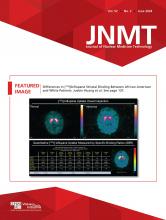Visual Abstract
Abstract
The introduction of PET/CT requires staff training, redesign of patient workflow, new skills, problem-solving abilities, and adjustments to radiation protection protocols. When PET/CT was introduced in the U.K., nuclear medicine technologists (NMTs) encountered challenges in defining their roles and unfamiliarity with the new technology and the new working procedures. Since the introduction of PET/CT in South Africa, the experiences of NMTs with this hybrid imaging device have not yet been described. Therefore, the aim of this research study was to explore and describe the experiences of NMTs working in PET/CT facilities in Gauteng Province, South Africa. Methods: This study had a qualitative, exploratory, descriptive design and used a phenomenologic research approach. Semistructured interviews were conducted to collect data until data saturation was reached. A software program was used to manage the codes, categories, and themes. Nine NMTs participated in the study: 5 from public hospitals and 4 from private hospitals. Their age range of 27–58 y provided the ideal heterogeneity for sharing experiences in working in PET/CT facilities. Results: Two overarching themes emerged from the categories: the perspectives of NMTs working in PET/CT facilities and the PET/CT challenges encountered by NMTs. The results suggest that NMTs experience joy and fulfilment from working in PET/CT facilities and regard PET/CT as the future of nuclear medicine. However, NMTs also experience a gap in PET/CT training and are concerned about the high radiation exposure associated with PET/CT imaging and about the lack of psychologic support. Conclusion: Although the NMTs enjoy working in PET/CT, they desire additional clinical training and psychologic support. Since radiation exposure in PET/CT is higher than in general nuclear medicine, radiation monitoring is imperative to minimize exposure to NMTs and patients.
Footnotes
Published online Feb. 13, 2024.
This article requires a subscription to view the full text. If you have a subscription you may use the login form below to view the article. Access to this article can also be purchased.
SNMMI members
Login to the site using your SNMMI member credentials
Individuals
Login as an individual user








